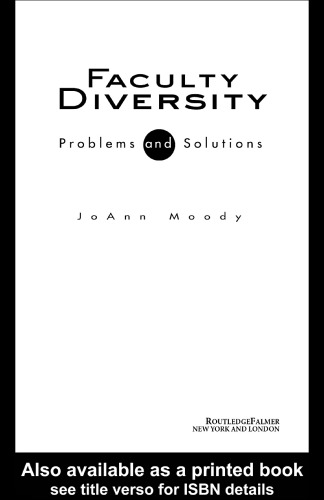(EBOOK PDF)Faculty Diversity Problems and Solutions 1st Edition by Joann Moody 0415948673 9780415948678 full chapters
$50.00 Original price was: $50.00.$35.00Current price is: $35.00.
Faculty Diversity Problems and Solutions 1st Edition by Joann Moody – Ebook PDF Instant Download/Delivery: 0415948673, 9780415948678
Full download Faculty Diversity Problems and Solutions 1st Edition after payment

Product details:
• ISBN 10:0415948673
• ISBN 13:9780415948678
• Author:Joann Moody
JoAnn Moody shows majority campuses, faculty, and administrators how to dismantle the high barriers that block women and especially minorities from entry and advancement in the professoriate. Good practices for improving recruitment, evaluation, mentorship, and retention are offered.
Faculty Diversity Problems and Solutions 1st Table of contents:
Acknowledgements
Introduction Organization of Faculty Diversity: Removing the Barriers
Organization of the Book: Part 1— Barriers to Faculty Diversity
Chapters 1 and 2: Rising Above Cognitive Errors
Chapter 3: Diversifying the Faculty Requires a Focus on Domestic Non-Immigrant Groups
Organization of the Book: Part 2—Removing the Barriers to Faculty Diversity
Chapter 4: Faculty Recruitment
Chapter 5: Faculty Retention
Chapter 6: Faculty Mentoring
Appendix
The Barriers to Faculty Diversity
Cognitive Errors that Contaminate Academic Evaluations and Block Faculty Diversity
Setting the Stage
An Overview of Cognitive Errors
Thirteen Cognitive Errors
1 First Impressions
2 Elitism
3 Raising the Bar
4 Premature Ranking/Digging In
5 The Longing to Clone
6 Good Fit/Bad Fit
7 Provincialism
8 Extraneous Myths and Assumptions (Including “Psychoanalyzing” the Candidate)
9 Wishful Thinking; Rhetoric not Evidence
10 Self-Fulfilling Prophecy
11 Seizing a Pretext
12 Assuming Character over Context
13 Momentum of the Group
Organizational Dysfunctions that Exacerbate Cognitive Errors and Unsound Evaluations
1 Overloading and Rushing the Search Committee
2 No Coaching and No Practice for the Committee
3 Failure to Consult Relevant Parties
4 No Ground Rules
5 Absence of Reminders and Checklists
6 Lack of Attention to Internal and External Monitoring/Accountability
7 Lack of Debriefing and Systematic Improvement
Negative Bias and Positive Bias Two Powerful Cognitive Errors that Impede the Advancement of Some Faculty and Speed the Advancement of Others
Section A Negative Bias (Cognitive Error #14) and Positive Bias (Cognitive Error #15)—and their Application to Gender and to Group Membership
Negative Bias: Regarding Gender
Negative Bias: Regarding Group Membership
Positive Stereotype/Bias: Regarding Gender and Group Membership
Section B How Negative Bias and Positive Bias Affect Faculty Members’ Professional Lives on a Daily Basis
Evaluation of Job Performance in the Classroom
Evaluation of One’s Research and Scholarship
Networks for Insiders and Exclusion for Outsiders
Conclusion and a Segue
Disadvantages for Non-Immigrant Groups but Advantages for Immigrant and “Honorary White” Groups
Section A Avoid Certain Misleading Terms: People of Color; Minority; Hispanic; Latino/a; Diversity or Multi-Cultural Faculty Hires
Be Careful with the Term “Diversity Hires”
Section B Distinctions Among Groups from Europe, Asia, India, Central and South America, the Middle East, the Caribbean, and so on
Differences Between Colonized Groups and Immigrant Groups
European-Descent Immigrants Become the Dominant Group and Consolidate their Economic and Political Power
European-American Labor Unions and Their Creation of Wealth or Poverty
Advantages Enjoyed by All or Most Immigrants (whether from Europe, Asia, India, or Elsewhere)
West Indians from the Caribbean (Category: Immigrants)
U.S. President Barack Obama
Cuban Americans (Category: Immigrants) and Puerto Rican Americans (Category: Colonized)
Mexican Americans (Category: Colonized)
American Indians (Category: Colonized)
Native Hawaiians (Category: Colonized)
African Americans (Category: Colonized)
The mid-1960s Collision of Domestic Affirmative Action and Global Immigration
Asian Americans from China, India, Korea, Japan, Hong Kong, Taiwan (Category: Immigrants)
Immigrant Status of Asian Americans Has Privileges
Intermarriage: An Immigrant Privilege
Housing Patterns and College Enrollment
Asian Americans’ “Model-minority” Problem
Vietnamese, Cambodian, Hmong, and Laotian (Category: Immigrant Refugees)
Distinctions Between Immigrant Groups and Colonized Groups: A Recap
Section C Outside the Borders of Academe—Typical Disadvantages Experienced by Faculty Members of Colonized Groups that May Contribute to High Attrition
Police Harassment and Danger for Certain Faculty and Their Offspring
Micro-Aggressions on a Daily Basis Committed by Ordinary People
Exclusion from Important Community, Civic, Housing, and Business Networks
Housing Segregation and Mortgage Finance Difficulties
Removing the Barriers to Faculty Diversity
Faculty Recruitment Replacing Dysfunctional Practices with Good Practices
Section A Prepare the Campus Community
Myths and Assumptions
Section B Prepare Faculty Search Committees and their Chairs
Dysfunctional Practices
Good Practices to Replace the Dysfunctions
Ground Rules Governing the Search Committee’s Work
Section C Roles for Provosts and Deans
Monitor of Search Committee Process
Participant in the Departmental Recommendation of New Hires
Monitor of the Equitable Distribution of Resources to New Hires and Continuing Faculty
Promoter of Faculty Diversity, Using the “Bully Pulpit”
Intellectual Leaders
Enforcer of Accountability
Financial Underwriter
Sufficient Resources and Skilled Staff Assistance for Search Committees
Targeted Hiring
Departmental Specialist to do Year-Round Recruiting (like a Talent Scout or an Athletic Coach) and Thereby Assist Search Committees
Financial Assistance with Spousal Job-hunting
Housing Assistance to New Hires
Cluster Hiring of Under-represented Women or Minorities
Visiting Scholars from URW and NI Groups
Women and Non-immigrant Speakers in Every Lecture or Seminar Series
Visiting Dissertation Scholars-in-Residence Program on Campus, or a Post-doc Program with Direct Connection to a Tenure-track Job
Conclusion
Faculty Retention Replacing Dysfunctional Practices with Good Practices
Dysfunctions in Faculty Retention
Section A Good Practices: Demystifying Workshops, Orientation Seminars, Writing and/or Support Groups for All New and Early-Stage Faculty
Professional Development Sessions, on a Constant Basis
Orientations for First-Year Faculty Hires
Writing and Support Groups to Improve the Quality of Life for Early-Stage Faculty
Section B Good Practices: Department Chairs Have Key Duties to Perform, Related to Faculty Development and Retention of Junior Colleagues
Essential Tasks for Chairs and Directors—Reducing Stressors and Helping to Increase Productivity for Early-Stage Colleagues
Chair’s Duties Owed to Brand-New Faculty Hires: A Checklist
Conclusion
Faculty Mentoring Replacing Dysfunctional Practices With Good Practices
Section A What are the Typical Dysfunctions and Myths that Block Effective Mentoring?
Myths About the Value of Creating Mentoring Relationships
Myths about the Design of Mentoring Programs
Section B Good Practices—Knowledge and Skills that Mentors Need to Help in Overcoming Dysfunctions
Preparing Mentors to Discuss with Mentees Eight Typical Stressors Facing Early-Stage Colleagues
How Can Mentors Help their Mentees Deal with Negative Bias and/or the Solo Phenomenon?
Section C Missing Elements in the Design of Formal Mentoring Programs
Experimenting with Various Modes of Mentoring
Transitional “At-Large” Mentor (such as the Faculty Director of a Mentoring Program or an Associate Dean)
Informal or Formal Mentor
Internal Mentor or External Mentor
Project-Oriented Mentor
Group Mentoring
Mentoring Networks, including Peer Mentors
Groups for Writing Support and Peer Mentoring
Zone Mentors
Search Committee Evolves into a Mentoring Committee for the New Hire
Enhancing the Quality of the Mentoring Relationship: Pointers for Mentors and Mentees
Frontloading— Start Early; Avoid Keeping a Mentee on Probation
Ask about Hurtful or Confusing “Critical Incidents”
Disclosure by the Mentor Can Build Trust
When Arguing, Use “I” Messages
Give Constructive Feedback
Gauging the Effectiveness of Mentor-Mentee Relationships and Overall Mentoring Programs
Secure Systematic Feedback and Help Mentors and Mentees Stay On Course
Outcomes Evaluation: Consistently Document Mentoring Program Outcomes
Section D An Effective Mentoring Program Requires Significant Roles to be Played by Provosts, Deans, and Other Academic Staff
Special Roles for Provosts, Deans and Department Chairs
Conclusion and Next Steps
1 Practice Makes Stronger Leaders
2 Prepare to Disarm Typical Resistances and Push-Backs
3 Can We Talk?; Interrupt the Silence
4 Change Agents
5 Chief Diversity Officers on Campuses: Build a Faculty Cadre
6 Keep Peer Review on the Hot Seat and Push Against False Precision
False Precision
7 Let’s Worry—Then Act
Appendix
Appendix A A Colonized Group in Another Country: The Same Caste-Like Pattern
Appendix B Imprisonment of African-American Men: A New Caste-System Invented in 1980
Appendix C Caste Systems
Appendix D Reproduction of Group Inequalities through Standardized and High-Stakes Testing
Scholastic Aptitude Test
Graduate Record Examination
Tests Serve the Interests of America’s Elite
The All-Important Cultural Context of Tests
Self-Screening Because of Standardized Tests
Now High-Stakes Tests for Younger Students
Appendix E Discussion Scenarios—Practice Exercises for Readers and Groups
Scenario #1: Faculty Search—Some Good and Bad Practices
Scenario #2: Third Week as a New Assistant Professor
Scenario #3: Conversation Between a Mentor and Mentee During the Mentee’s Second Week as a New Assistant Professor
Scenario #4: A Glimpse of a Medical School Mentoring Relationship in its Third Year
Bibliography
About the Author
Index
People also search for Faculty Diversity Problems and Solutions 1st:
faculty diversity problems
faculty diversity in higher education
faculty diversity and student success
faculty diversity statements
faculty diversity program
Tags:
Faculty Diversity,Diversity Problems,Joann Moody



